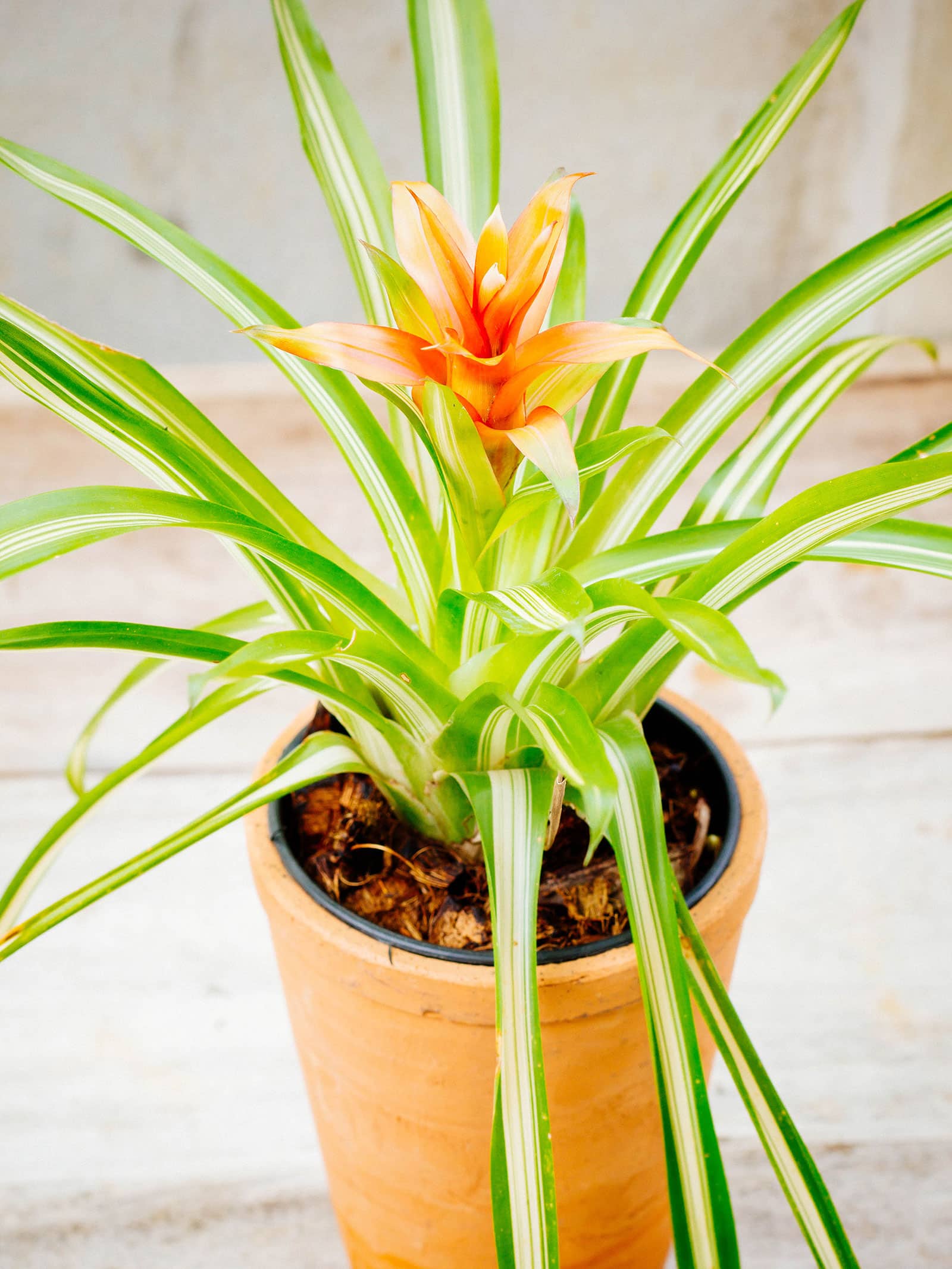Did you come across a pineapple-like tropical houseplant with a big, colorful flower in the center at your local supermarket or nursery? Or maybe you were gifted one? Chances are it’s a Guzmania bromeliad, a plant that gives off all the island vibes and is highly sought after for its amazing blooms. But… now what? How do you make sure your brand new plant thrives?
Although bromeliads like Guzmania come with some special care guidelines, they’re not difficult to keep alive at all once you’ve got the hang of them. Here’s how you can easily care for your bromeliad!
| Common name(s) | Guzmania bromeliad, tufted airplant |
| Scientific name | Guzmania sp. |
| Family | Bromeliaceae |
| Height & spread | Up to 3 feet high and 2 feet wide |
| Light | Bright indirect |
| Soil type | Orchid bark or no soil |
| Water | See watering section |
Disclosure: If you shop from my article or make a purchase through one of my links, I may receive commissions on some of the products I recommend.
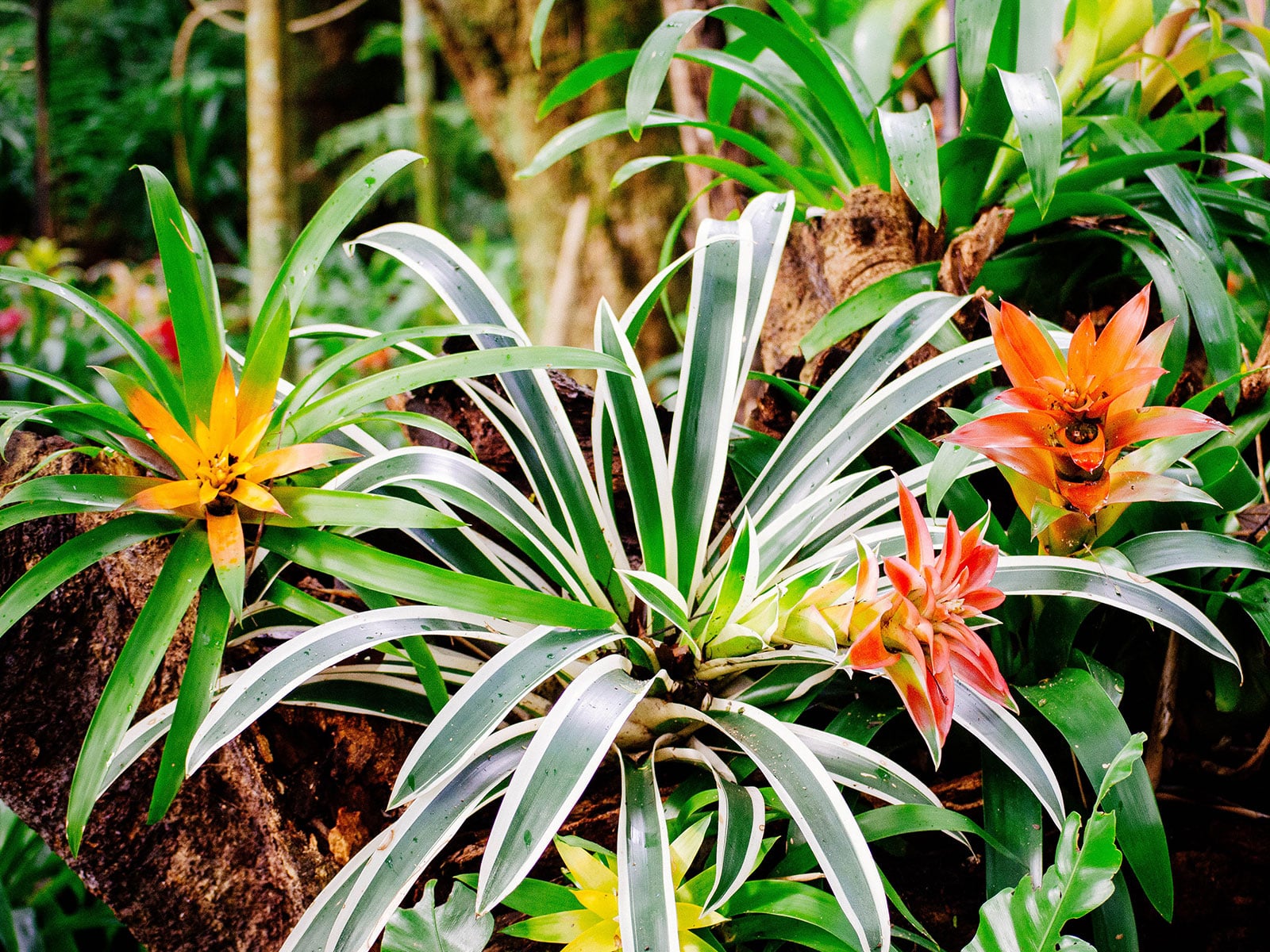
About Guzmania
Description
I love talking about oddball houseplants, and bromeliads definitely fit the bill. They’re delightfully weird! The genus Guzmania is no exception. It belongs to the subfamily Tillandsioideae, a name you may recognize—these bromeliads are closely related to air plants. In fact, they’re sometimes referred to as the “tufted air plant”!
You can recognize a Guzmania by its shape. These plants don’t have stems or normal leaves. Instead, they consist of a type of elongated modified foliage called bracts, which sprout like a fountain from a central point. In the middle is a reservoir that holds water, which may look like a recipe for a rotting plant but is actually essential to the bromeliad’s growth. It’s usually called a cup or vase.
The Guzmanias you’ll find for sale will usually be in bloom, having sprouted a colorful (red, pink, yellow, orange) inflorescence. The appearance of this extremely long-lasting flower varies by species. In some, it looks just like a colorful, smaller copy of the original plant, while in others, it may resemble a pinecone.
In the wild, like many other bromeliad species, Guzmanias are epiphytes. This means they don’t naturally grow in soil, but instead use other plants—mostly trees—as support. They’re non-parasitic, using their hosts only for support rather than stealing nutrients from them.
Natural habitat
Guzmania bromeliads are naturally found from as far north as Florida to as far south as Brazil. In their natural range, these plants inhabit moist and shaded rainforest habitats, which range from tropical to relatively cool in terms of temperature.
The genus isn’t fussy about altitude; it pops up anywhere between sea level to seriously high mountain ranges (11,000+ feet elevation).
Did you know?
Of the 200+ recognized members of the genus Guzmania, many are unfortunately listed as Vulnerable, Endangered, or even Critically Endangered by the IUCN Red List.

Guzmania varieties
By far the most popular Guzmania bromeliad to sold as a houseplant is called Guzmania lingulata. Commonly known as the scarlet star, this species looks like a typical Guzmania: a rosette of up to 18-inch long strappy leaves and a water reservoir in the middle. The flower is indeed red to orange, glossy, and kind of resembles a torch.

The other species you’re most likely to come across for sale are:
- Guzmania conifera: Known for its dazzling, pinecone-shaped inflorescence, which is bright orange with yellow tips.
- Guzmania monostachia: Reddish, more elongated flower with short leaves.
- Guzmania musaica: This species’ orange blooms aren’t quite as cool to look at, but it makes up for that with its tiger-striped foliage.
- Guzmania sanguinea: Inconspicuous flower, but when it blooms, the leaf tips turn an amazing orange-red.
But wait! The range of Guzmania varieties you may find for sale at your local plant shop or garden center doesn’t end here. This has been a popular houseplant for a long time, meaning nurseries have had plenty of time to develop different cultivars (varieties of plants, often hybrids, bred selectively to emphasize a certain trait).
The most common cultivar in most plants is a variegated one, and this is no exception. Guzmania ‘Variegata’ can be recognized by the cream stripes on its green foliage.
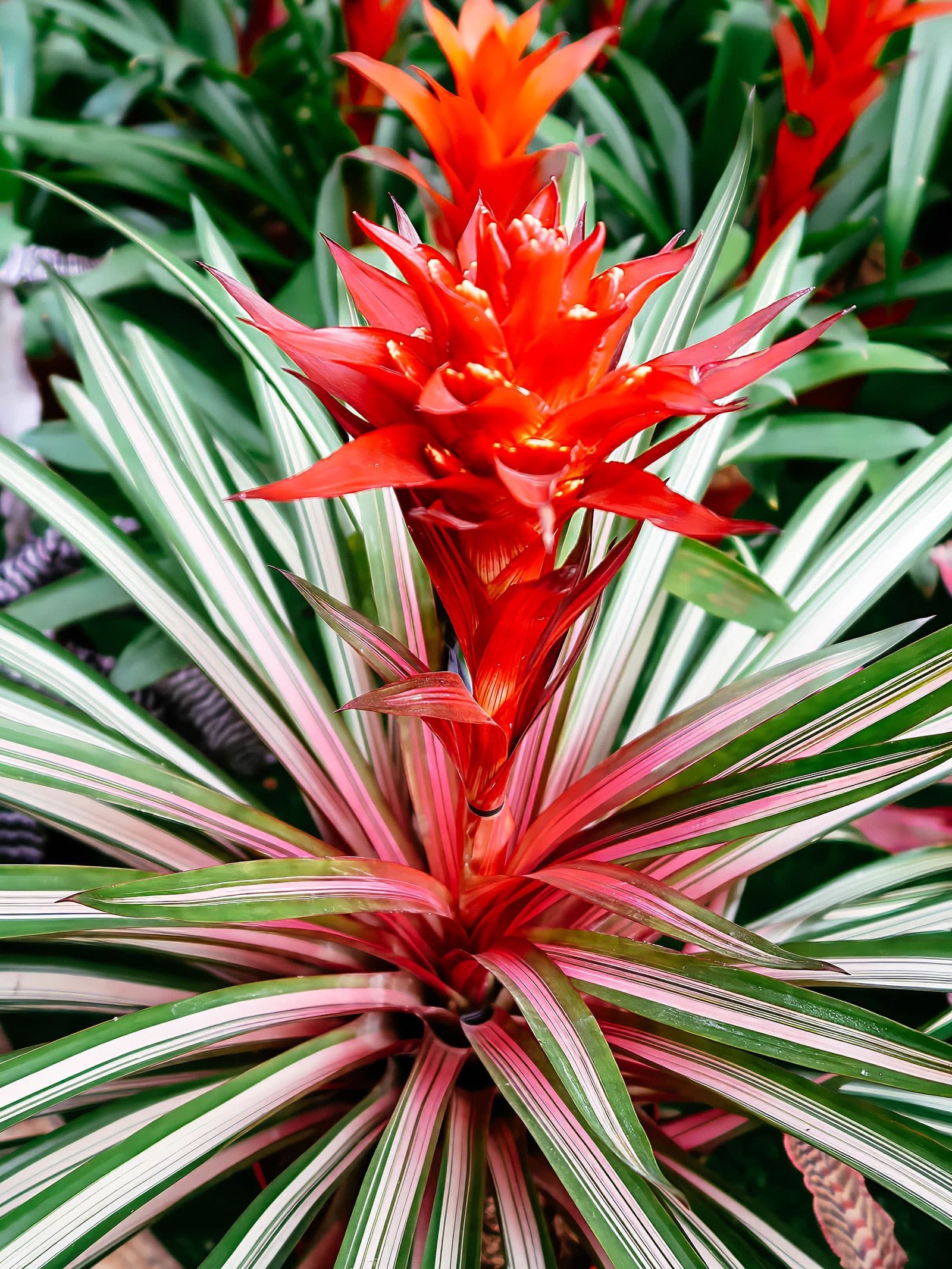
Here are a few of the other popular Guzmania cultivars and what sets them apart:
- Guzmania ‘Candy’: A pretty complicated hybrid according to Bromeliad Society International, consisting of (G. lingulata × conifera) × alborosea. Gorgeous pink inflorescences with cream-colored tips.
- Guzmania ‘Tala’: Definitely a variety of G. conifera, but with darker, brownish-green foliage. Exact origins unknown.
- Guzmania ‘Allura’: Patented in 2013 by a Dutch company that has produced many Guzmania cultivars. A cross between G. lingulata × wittmackii characterized by its long-lasting, bright red flower.
- Guzmania ‘Misty’: By the same company as ‘Allura’, patented in 2009. A cross between G. dissitiflora × kennedii, characterized by its firework-shaped pink flowers with yellow tips.
- Guzmania ‘Theresa’: Not much is known about its origins, but what we do know is that it’s tiny! A dwarf Guzmania with an orange-yellow flower.
- Guzmania ‘Hope’: Nothing to be found about one’s parentage either, but it’s definitely a looker, with a flat-topped and white-tipped red bloom.
- Guzmania ‘Priscilla’: Rather compact, with a stubby, bright red flower.
where to buy

Caring for Guzmania
Light and temperature
When trying to figure out the ideal placement for a plant in your home, it’s always helpful to keep its natural way of growing in mind. In this case, consider that Guzmania bromeliads grow on other trees in the rainforest. They’re used to receiving plenty of light, but direct sun is filtered out by the canopies of taller trees.
So, your best bet is to place your bromeliad on a nice and bright windowsill, but not one that receives harsh afternoon light. This species is reasonably tolerant to low light conditions, but there’s a higher risk of rot and your plant may not manage to flower if it’s kept in the dark.
As for temperature, these bromeliads are actually quite adaptable. After all, some are found in hot and humid jungle environments, while others grow in cooler cloud forests. In fact, even Guzmanias of the same species may thrive in a wide range of temperatures!
As a rule of thumb, it’s best to avoid exposing your plant to temps below 60°F. Place it away from A/C units or drafty windows. If you feel comfortable in your home, then the same applies to your plant.
Soil and planting
Pay attention here! As I mentioned earlier, Guzmanias are epiphytes. They’ve evolved to grow on trees rather than in the soil. Their roots aren’t adapted to being in regular potting soil and are prone to rot; they function as anchors, not to absorb water and nutrients.
Like other epiphytes, notably orchids, bromeliads like a nice and airy soil mixture that doesn’t choke their roots. In fact, you can actually use orchid soil for your Guzmania. It usually consists of fine bark chips, meaning there are lots of air pockets and moisture drains quickly enough to prevent any issues.
Although pure orchid bark should work, I like to up my game a bit and also add a little sphagnum moss. The type of planter doesn’t really matter as long as there’s a drainage hole in the bottom.
And by the way, you can actually consider foregoing the soil entirely. If you’d like to see a Guzmania grow as it naturally would, you can mount yours on a tree branch or log! It’s easy: just loosely pack some sphagnum around the roots and secure the plant with fishing wire until its roots have taken hold.
Recommend products for Guzmania bromeliad plant care:
- Leaves & Soul Premium Potting Soil for Orchids, Bromeliads, and Epiphytic Plants
- Espoma Organic Potting Mix for Orchids and Bromeliads
- Better-Gro Orchid Bark
- Better-Gro Orchid Moss
Water and humidity
Okay, so we’ve established that epiphytes have some special soil requirements. As you can imagine, the same goes for watering, because their roots are adapted to life in the trees rather than in the substrate. So how does that work?
Well, the interesting thing is that there are two ways to water a Guzmania. It’s actually the subject of a lot of heated debate in the houseplant world, with some saying that you shouldn’t wet the soil at all and others stating that these plants can adapt to soil watering as long as you’re consistent about it.
If watering “normally” is your preferred method, you can go ahead and keep the soil lightly moist. No wet feet please, or your plant will soon start rotting! It should theoretically do fine this way.
This being said, I personally prefer not to bother too much with normal waterings. Instead, I make use of a nifty trait that Guzmanias developed in order to stay hydrated: their central cup or vase (or tank, or urn…). This is a natural reservoir formed by the way the leaves meet at the base of the plant.
In the wild, the cup will fill with rain. Tiny hairs inside, called trichomes, absorb the water and nutrients into the plant as needed, bypassing the roots entirely. In our homes, we can use filtered water to keep the cup filled around a quarter of the way (less if it’s cold or your plant doesn’t get a lot of light; more if you live in a hot and dry climate).
In order to prevent mineral build-up and bacteria growth, give the cup a good flush with fresh, clean water on a monthly basis.
Lastly, keep an eye on the humidity in your home. Guzmanias don’t like it when the air moisture level regularly drops below 50 percent, so if this is the case, you may want to consider running a small humidifier. Your plants (and your sinuses) will thank you.
Quick Tip
If you mounted your Guzmania on wood, you can spray the leaves and the sphagnum moss around the roots daily in addition to keeping the central cup partially filled.
Fertilizing
Bromeliads don’t tend to be heavy feeders, because in the wild they have to rely entirely on bits of leaf, bird poop, and other debris that falls on them from above. However, they don’t say no to a bit of plant food either, as long as you don’t overdo it.
You can use a small amount of liquid orchid or bromeliad fertilizer during the summer growing season, preferably around once a month. It’s best to dilute it to around one-third of the amount suggested on the bottle; too little is really better than too much here.
You can also regularly use a foliar fertilizer meant for closely related Tillandsia air plants, because Guzmanias do absorb nutrients through their leaves. These mixtures are usually highly diluted, so you can use them once or twice a month just fine.
Be sure not to apply any fertilizer directly to your bromeliad’s cup, or if you do, don’t forget to flush the cup one to two days after. Otherwise, the organic material and mineral build-up can cause issues like rot or burn.
Recommended fertilizers for Guzmania bromeliads:
- The Grow Co. Organic Air Plant Food
- Cute Farms Tillandsia Air Plant Fertilizer
- Aquatic Arts Air Plant Fertilizer
- Grow More Ready-to-Mix Bromeliad Tillandsia Food
Pruning
Guzmanias aren’t among the houseplants that require regular pruning. You can remove dead foliage regularly, though. You’ll also have to do some maintenance after the plant has finished blooming, but we’ll discuss that in the section on propagation below.
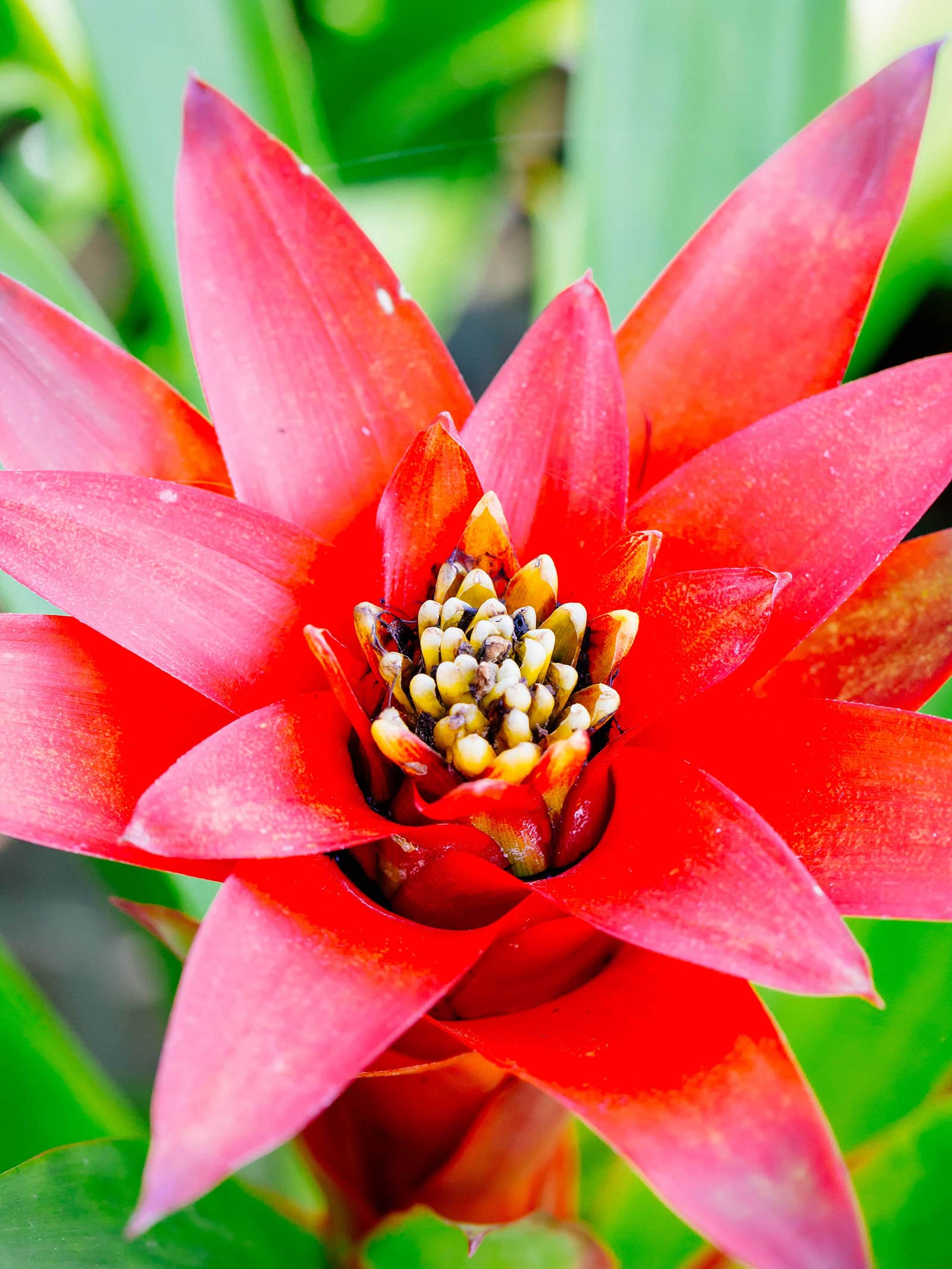
Propagating Guzmania
Did you know that bromeliads are monocarpic? This means they’re only capable of blooming once—they give up the ghost once their flowers are spent. Luckily for us, though, this doesn’t mean you’ll have to throw your Guzmania in the trash after just a few weeks.
First off, bromeliad blooming time is pretty crazy. Their flowers (bracts) can last up to four months! These bracts provide the wow factor; the actual flowers are small and nothing to write home about.
In fact, this is one thing you should look for when buying a Guzmania: if the white flowers inside the colorful flowerhead are fully open, your plant won’t last long.
Luckily, once they’re finally done blooming, they send out one last hurrah in the form of one or multiple offsets. By the time the mother plant is dead, there will usually be a bunch of babies happily growing along next to her.
Of course, a big dead plant with a bunch of live offshoots around it isn’t the nicest thing to look at. That’s why most Guzmania enthusiasts wait with repotting and other maintenance until the above happens, making it easy to fix everything at once.
Here’s what I do when my Guzmania mother plants die:
- If it’s winter, I wait until spring, when the growing season starts. Summer is also fine.
- Pop the dead mother plant and her pups out of their planter. Sever the pups’ connection to the mother using clean pruning shears if they haven’t disconnected by themselves yet.
- Discard the dead plant; it won’t re-sprout. Also discard (or compost) the old soil.
- Decide whether you would like to keep the babies together in a big display or pot them separately. Gather the amount/size(s) of planter(s) you need.
- Prepare enough of your preferred Guzmania soil mixture to fill the planter(s).
- Place the offsets in the planter(s) and care for them as usual. They might sulk a bit, but they’ll soon perk up.
Voilà, from death sprouts new life. Instead of a single Guzmania, you now (usually) have multiple. The pups will keep growing and should bloom in three to four years with the right care.
If your dead Guzmania was mounted on wood, you can carefully dislodge the roots to remove it. Gather its pups and attach them to the same branch together—or give them all a separate one to live on.
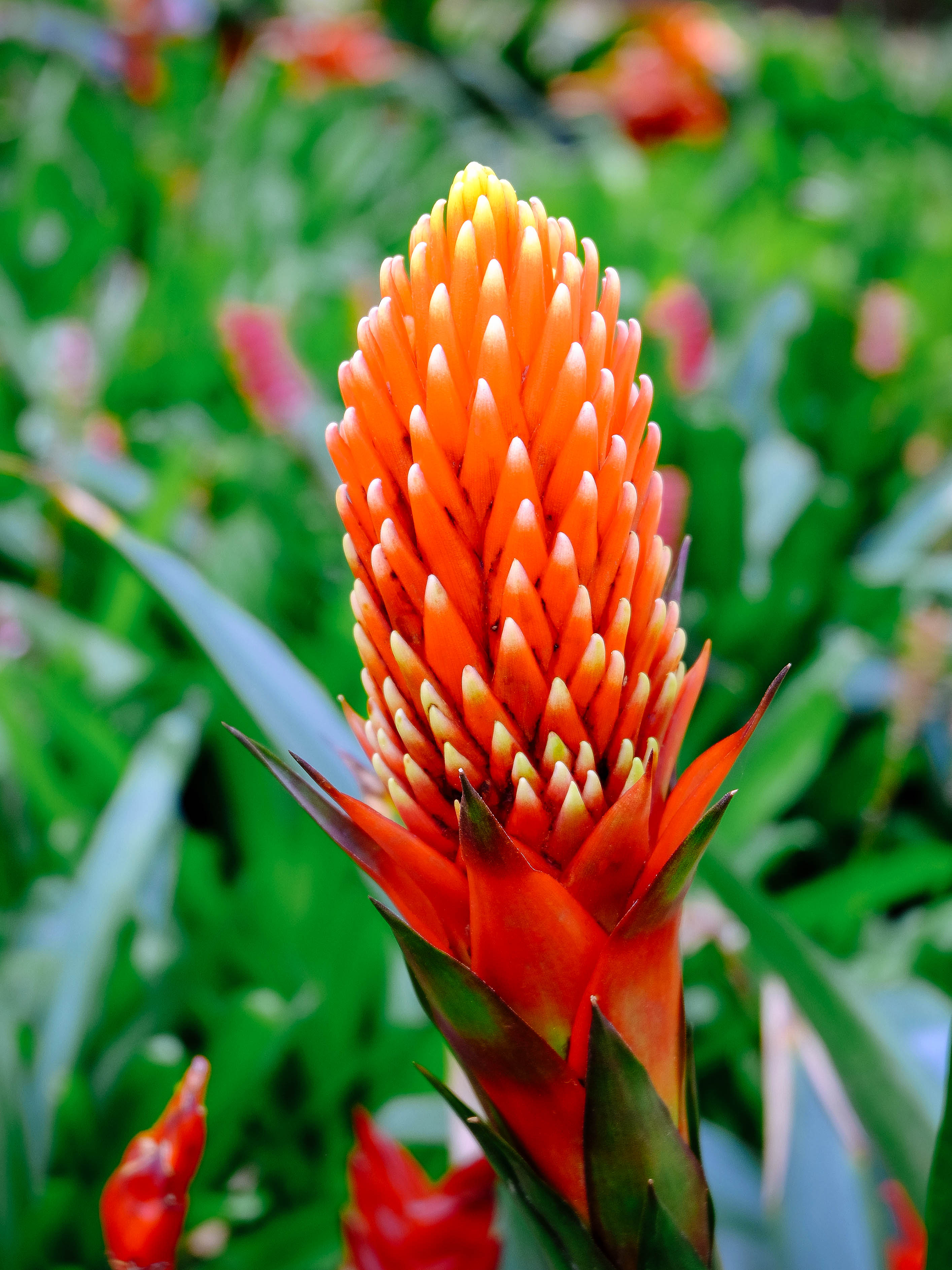
Is Guzmania toxic to cats and dogs?
Nope! Bromeliads, including this one, are not toxic. No need to worry if your furry friend has taken a bite out of your Guzmania (except maybe about the plant).
Sources:
- Zotz, G., Leja, M., Aguilar-Cruz, Y., & Einzmann, H. J. (2020). How much water is in the tank? An allometric analysis with 205 bromeliad species. Flora, 264, 151557.
- Vanhoutte, B., Ceusters, J., & De Proft, M. P. (2016). The ‘tubing’ phenomenon in commercial cultivation of Guzmania: morphology, physiology and anatomy. Scientia Horticulturae, 205, 112-118.


